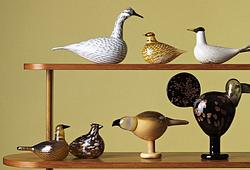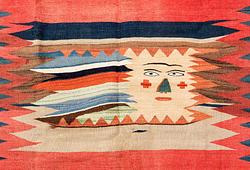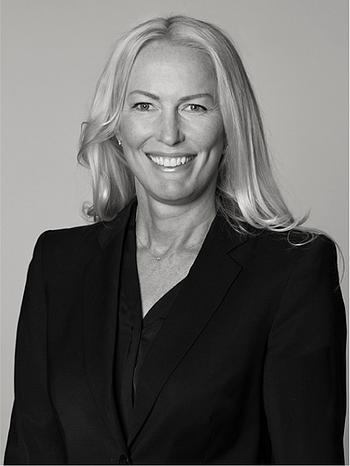Birger Kaipiainen
A ceramic sculpture of a bird, Arabia, Finland 1958.
Metal legs and beak, attached to a metal plaque. Richly decorated with clocks, etc, Signed KAIPIAINEN ARABIA. Height 53 cm, length ca 62 cm.
Repair to the head, one gem to the chest later, some retouches, small chip to tail.
Näyttelyt
The sculpture exhibited at Birger Kaipiainen's solo exhibition in the Wärtsilä Shop showroom in Helsinki 1958.
Muut tiedot
Birger Kaipiainen (1915-1988) was a ceramic artist with a very special design language that exposed a rich fantasy of his. Kaipiainen was employed by Arabia as a 22-year-old in 1937 and stayed there until 1954 when he went to Sweden to work at the Rörstrand factory between 1954 and 1958. He then returned to Finland
and to Arabia where he remained until his death in 1988.
Birger Kaipiainen's earliest production was inspired by for instance the Byzantine art, he often used a sgraffito technique when working on the decorations.
The decorative and flowering chargers as seen from Kaipiainen's later production, perhaps what he is best known for, were usually built up with the relief effect of ceramic beads and the glazes were often colourful and intense, sometimes with iridescent hues of the glaze. In addition to the flowers and the fruits his motifs also featured various animals. The birds were the most common ones.
Kaipiainen began experimenting with pure sculptural motifs with birds in the late 1950s and received the Grand Prix at the Triennale in Milan for a sandpiper bird sculpture in 1960.
This sandpiper sculpture that Bukowskis have the pleasure of selling is made in 1958 and has a body entirely in ceramics. The decoration shows a variety of clocks, a recurring motif in Kaipiainen's visual world which is said to have reminded Kaipiainen of the young friend Kuovi who spoke about the migratory birds' intrinsic clock.
This sandpiper sculpture forebode the pearl birds that came to make Kaipiainen internationally known. These birds were made by first creating a steel skeleton that built up the shape, which was clad with hand-rolled ceramic beads and sometimes provided with other decorative elements.
The auction's sculpture is documented from Kaipiainen's separate exhibition at Wärtsilä in Helsinki in 1958.
Suunnittelijat
Birger Kaipiainen aloitti Arabian taideosastolla heti valmistuttuaan vuonna 1937, ja löysi nopeasti oman tapansa tehdä taidetta. Kaipiainen koki uransa alkuvuosina henkilökohtaisessa elämässään menetyksiä, jotka yhdessä pian alkaneen talvisodan kanssa loivat synkän varjon taiteilijanuran alkuun ja näkyivät surumielisyytenä ja haikeutena hänen varhaisissa töissään. Niitä hallitsevat pastellisävyissä kuvatut eteeriset, sadunomaiset hahmot, joissa voi nähdä viittauksia Italian varhaisrenessanssiin sekä kaipuuta kauniimpaan maailmaan.
1950-luvulla Kaipiaisen töissä alkoi olla kolmiulotteisuutta ja graafisempaa tyylittelyä. Myös värimaailma muuttui vähitellen tummemmaksi ja voimakkaammaksi. Vuodet 1954-1958 Kaipiainen vietti Ruotsissa työskennen ateljeetaiteilijana Rörstrandin posliinitehtaassa. Tuona aikana taiteilija sai toteuttaa itseään vapaasti, ja hänen tuotantonsa alkoi kulkea yhä surrealistisempaan suuntaan. Vuosikymmenen läpi toistuneeksi aiheeksi vakiintuivat pyöreäkasvoiset ja suppusuiset naishahmot, jotka joko nousivat irti pöytä- tai seinäpinnasta tai sitten seisoivat vapaasti toteemimaisina hahmoina.
Ruotsista palattuaan Kaipiainen oli jo tunnettu taiteilija niin kotimaassa kuin ulkomailla, ja hän sai myös Arabian taideosastolla entistä enemmän vapautta toteuttaa itseään. Omaa polkuaan kulkeneen taiteilijan tuotannossa alkoi noihin aikoihin nousta keskeiseksi muodon ohella myös esineen pinta. 1960-luvulla Kaipiainen toi taiteeseensa ihmetystä herättäneet, rautalankaan pujotetut ja lautasten pintoihin kiinnitetyt keramiikkahelmet. Samalla ihmishahmot jäivät hänen aiheinaan yhä vähemmälle, ja teokset alkoivat olla entistä suurikokoisempia ja koristeellisempia.
Lue lisää














































